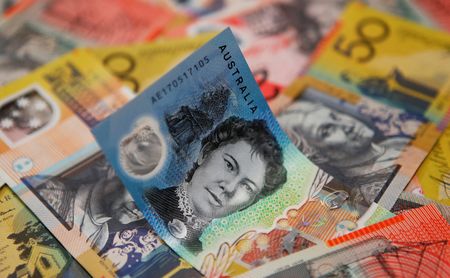
By Kevin Buckland
TOKYO (Reuters) – The Australian and New Zealand dollars retreated from near two-month highs on Monday after a new batch of dissappointing data from China, a key trading partner, while the yuan weakened following a surprise rate cut.
The greenback edged higher as traders continued to hawkish comments by Federal Reserve policymakers’ against signs that U.S. inflation may have peaked.
The U.S. dollar index, which gauges the currency against six major peers, edged 0.04% higher to 105.74, consolidating near the middle of its range this month.
The onshore yuan eased to a one-week low of 6.7620 per dollar, compared with the previous close of 6.7430, after the People’s Bank of China unexpectedly lowered borrowing costs on medium-term policy loans and a short-term liquidity tool for the second time this year.
New Zealand’s kiwi slumped 0.6% to $0.64165, pulling away from Friday’s high at $0.6468, the strongest level since June 8.
The Aussie slid 0.58% to $0.70805, falling further away from the recent peak last Thursday, when it struck the highest since June 10 at $0.7136.
Chinese industrial output, retail sales and fixed-asset investment all fell short of analyst estimates on Monday, as a nascent recovery from draconian COVID-19 lockdowns faltered.
“Despite the warning of inflation risk and flush liquidity conditions, the dominant downside risks from the COVID spread and property-sector rout prompted the PBOC to cut rates to stimulate demand,” said Ken Cheung, chief Asian FX strategist at Mizuho Bank.
Meanwhile, U.S. data on Friday showed the first decline in import prices for seven months, following statistics earlier in the week that showed consumer and producer prices also cooling.
That has fueled investor hopes for less aggressive Fed tightening, despite Richmond Fed President Thomas Barkin joining the chorus of hawkish rhetoric by telling CNBC on Friday that he would like to see inflation running at the Fed’s 2% target for “some time” before stopping rate hikes, adding there’s “still more to come to get into restrictive territory.”
Analysts will scour minutes of the Fed’s most recent meeting, due to be released on Wednesday, for more clues on policymakers’ thinking, while retail sales data on Friday will give some fresh insight on the economy’s health.
“A growing narrative of a soft landing has taken hold, gaining traction after some easing in price indicators, with some interpreting that as allowing the Fed to ease up on the pace of hikes,” Tapas Strickland, a markets economist at National Australia Bank, wrote in a client note.
The minutes are a risk though, and “may push back on the notion of a Fed pivot,” Strickland said.
Money markets now price 44.5% odds of another 75 basis-point rate hike by the Federal Open Market Committee in September, versus 55.5% probability of a slowing in the pace of tightening.
The euro eased 0.1% to $1.02475, weighed down by Europe’s struggles with the war in Ukraine, the hunt for non-Russian energy sources and a hit to the German economy from scant rainfall.
Sterling slipped 0.14% to $1.21185.
Against the yen though, the dollar sank 0.27% to 133.225 amid an easing in long-term U.S. Treasury yields.
Leading cryptocurrencies bitcoin and ether rose back toward more than two-month peaks, with a much-delayed upgrade to the latter’s network all but certain to happen in September.
Ethereum’s so-called “merge” promised a 99.95% reduction in the blockchain’s energy consumption, preparing it for faster transactions.
Bitcoin last rose 2.11% to $24,833, after earlier touching $25,212 for the first time since June 13.
Ether gained 1.81% to $1,971.90, approaching Sunday’s peak of $2,031.56, the highest since May 23.
(Reporting by Kevin Buckland; Editing by Simon Cameron-Moore)

